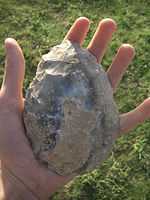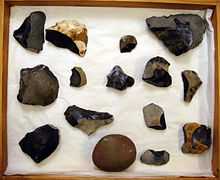Eartham Pit, Boxgrove
| Site of Special Scientific Interest | |
 One of the quarries at Eartham Pit. | |
 Shown within West Sussex
| |
| Area of Search | West Sussex |
|---|---|
| Grid reference | SU923087 |
| Coordinates | 50°52′13″N 0°41′15″W / 50.870309°N 0.687409°WCoordinates: 50°52′13″N 0°41′15″W / 50.870309°N 0.687409°W |
| Interest | Geological |
| Area | 9.83 ha (24.3 acres) |
| Notification | 1997 |
| Natural England website | |
Boxgrove Quarry is a gravel quarry and Lower Palaeolithic archaeological site at Boxgrove in the British-English county of West Sussex. It has been designated a Site of Special Scientific Interest.[1] When excavations began in 1983 flint tools 500,000 years old were discovered, which at that time was the oldest evidence of humans ever discovered in the UK. In 2005 flint tools 700,000 years old were discovered at Pakefield, and in 2010 flint tools at least 800,000 years old were discovered at Happisburgh. However Boxgrove remains a site of national archaeological importance because of the discovery in 1994 and 1995 of 500,000 year old early human fossils, which remain the oldest such fossils ever discovered in the UK. The other key paleolithic sites in the UK are Swanscombe, Pontnewydd, Kents Cavern, Paviland, and Gough's Cave.
Parts of the site complex were excavated between 1983 and 1996 by a team led by Mark Roberts of the Institute of Archaeology, University College London. The site is situated in an area that features a buried chalk cliff that overlooked a flat beach (which contained a waterhole) stretching around half a mile (1 km) south to the sea.
History
The site is important for many reasons, including the degree of preservation of the landscape, the impressive size of the undisturbed ancient land surface, its huge quantity of well-preserved animal bones, its numerous flint artifacts, and its hominid bones which are among some of the most ancient found yet in Europe. Several of the animal bones are the oldest found specimens of their species, such as the wing bone of the Great Auk found at the site in 1989. The combination of bones, stone artifacts, and the geology of the landscape gives a very complete picture of the coastal plain as it existed half a million years ago.[2]


Numerous Acheulean flint tools and remains of animals dating to around 500,000 years ago were found at the site. Some of the bones were found to display cut marks, and some of the tools bear use wear traces indicative of cutting meat, indicating that the site was used for butchery by some of the earliest occupants of the British Isles. They shared the area with a wide variety of animals whose bones have been found there, including lions, bears, rhinos and giant deer, as well as numerous smaller animals such as frogs, voles and birds. Comparison with ethnographic and experimental examples of stone-tool-assisted butchery has shown that game animals at Boxgrove were expertly butchered, and it is likely that the variety of animal life in the area attracted human hunters. Evidence for hunting is, however, tentative, consisting primarily of a horse shoulderblade with a semicircular hole that has been interpreted as a projectile impact mark. No obvious hunting equipment has been found.
Remains of Homo heidelbergensis were first found on the site in 1994, comprising the partial tibia of a male who probably stood 1.8m high and weighed around 80 kg. Significantly, this is the only postcranial hominid bone to have been found in Northern Europe (in other words, coming from anywhere other than the skull). Both ends of the bone show signs of gnawing, possibly by a wolf, suggesting that perhaps the Boxgrove hominids were sometimes prey to other animals. In 1996 two incisor teeth from another individual were found. These show evidence of severe periodontal disease and show tool cut marks, which are thought to have been caused by use of flint tools near the mouth rather than indicate cannibalism.
In 2003 English Heritage announced it would buy the remains of the quarry to ensure the preservation of the site complex. [3]
Excavation
"Boxgrove is simply one of the great Early Palaeolithic/Middle Pleistocene sites in the world, this statement has nothing to do with ego or anything else personal to myself - it just is. The quality of preservation, the range and depth of its myriad lines of multidisciplinary evidence are beyond nearly all other sites."
Roberts went on to gain a name for himself in the archaeological community as site director of the Boxgrove project. The Palaeolithic archaeologist A.M. Chadwick mentioned that site director Mark Roberts "is a noted shooting and fishing man, and whilst I was at Boxgrove in 1988, wild game constituted a substantial part of the menu (even including a seagull on one memorable and not too successful occasion!)."[5]
In 2011, Roberts told interviewers from the student-produced archaeological magazine Artifact that Boxgrove was "a fickle mistress indeed" and that whilst he wouldn't change his experience in investigating the site, the excavations "extracted a very heavy price" from him, "a price that I am only just at the point of paying the final instalment on". For this reason he found that he often hummed The Specials' 1979 song "Too Much Too Young" to himself when thinking about the project.[6]
Publication
In 1998, Roberts co-wrote a book about the site with prehistoric archaeologist Mike Pitts that was entitled Fairweather Eden: Life in Britain half a million years ago as revealed by the excavations at Boxgrove. Published by Arrow Books, Fairweather Eden was designed for a popular audience. One reviewer of the book, A.M. Chadwick, noted that within it:
- Mark Roberts, is given centre stage, but this is at the expense of other participants in the project. Almost prescient powers of perception and forward-thinking are attributed to Mark Roberts, and some of the book's more purple passages describe these… What we are presented is a picture of a lone archaeological warrior battling against the archaeological establishment. Whilst this may have been true of the project's early years, modern multidisciplinary research projects simply do not work like that.[5]
See also
- Gough's Cave
- Genetic history of the British Isles
- Happisburgh
- Kents Cavern
- List of human evolution fossils
- List of prehistoric structures in Great Britain
- Pakefield
- Prehistoric Britain
- Paviland
- Pontnewydd
- Swanscombe
References
- Footnotes
- ↑ SSSI Citation — Eartham Pit (PDF). Natural England. Retrieved 3 May 2009.
- ↑ Pitts, M. & Roberts, M. "Fairweather Eden". Fromm International: New York, 1997. ISBN 0-88064-247-5
- ↑ Research and Conservation framework for the British palaeolithic (PDF). English Heritage. p. 9. Retrieved 1 November 2010.
- ↑ Kontonicolas, Ali and Roberts 2011. p. 13.
- ↑ 5.0 5.1 Chadwick, A.M. 1998. Review of Fairweather Eden. Available at http://ads.ahds.ac.uk/catalogue/adsdata/assemblage/html/4/4pit_rob.html
- ↑ Kontonicolas, Ali and Roberts 2011. pp. 12-13.
- Bibliography
- Pitts, Michael and Roberts, Mark (1998). Fairweather Eden: Life in Britain half a million years ago as revealed by the excavations at Boxgrove. London: Arrow. ISBN 978-0-09-964491-0.
- Kontonicolas, MaryAnn and Ali, Irrum; Roberts, Mark (subject) (Winter 2011). "Disco in Boxgrove". Artifact Magazine 01 (London). pp. 12–13.